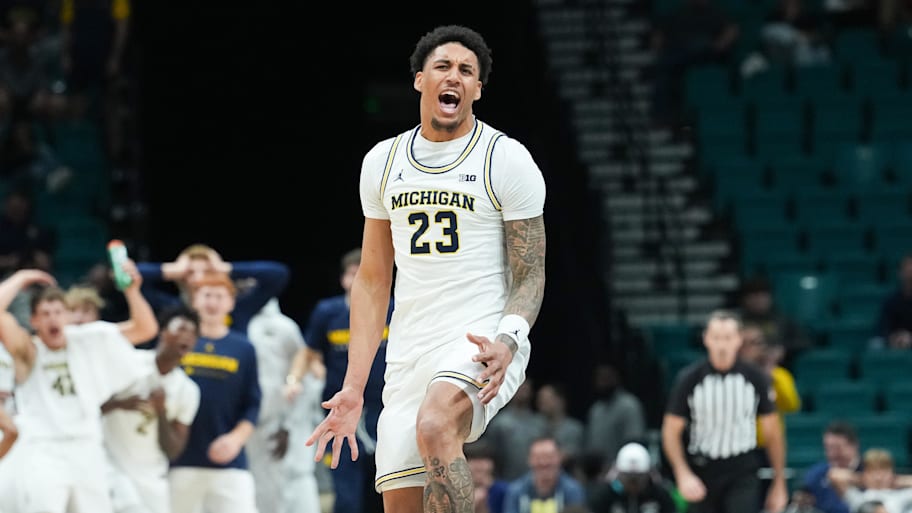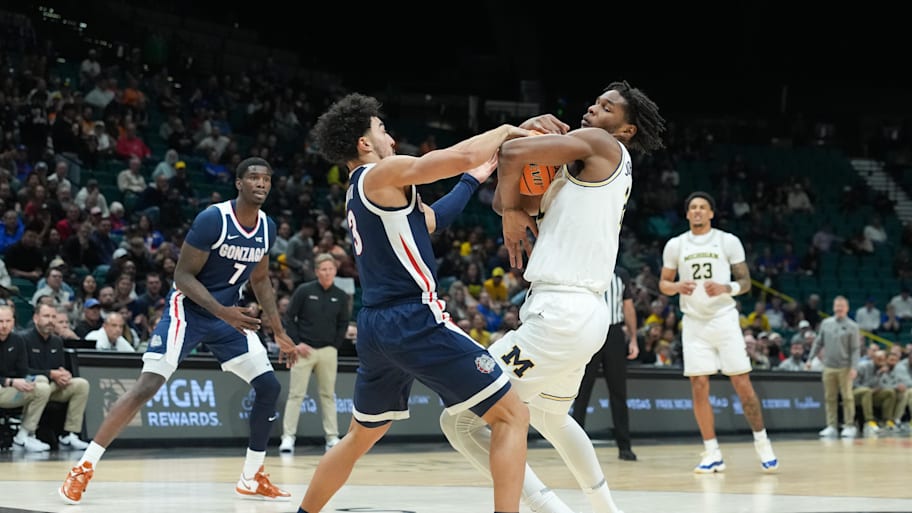
LAS VEGAS — Michigan vs. Gonzaga was supposed to be the biggest game of men’s college basketball’s Feast Week.
The Players Era Championship gobbled up nearly half of the nation’s top 20 teams and placed them in an unconventional, modified pool-play format with eyes on shaking up November college hoops. The prize fight of the four-day extravaganza was supposed to display two of the sport’s best.
Instead, it was never even close. The rout was on before the first media timeout, and by the second half was a dunk show of epic proportions put on by the Wolverines. The final tally: 101–61, as loud a possible statement that the Wolverines are very much for real.
“Today was just putting the world on notice that we’re here to be the best team in the nation,” Michigan forward Yaxel Lendeborg said.
The mood around Michigan is a complete 180 from a mildly disappointing start to the season. The Wolverines started the season 4–0 heading into Las Vegas, but hadn’t played up to their ability in nail-biting wins against Wake Forest and TCU. The rollout of their new personnel was clunky at times on the offensive end, and it was clear the Wolverines weren’t happy with the way they were playing.
“Those games that were pretty close, we all treated those games like we lost, you know?” Lendeborg said. “No one was really satisfied and proud with those wins. It basically [didn’t] feel like we were 6–0, it’s like we were 4–2 or something.”
So Michigan doing what it did at Players Era, with wins of 40, 30 and then 40 points again, was astonishing, something Wolverines coach Dusty May said he “never would’ve dreamed this would happen in a million years.” A roster that two weeks ago felt like a work in progress now appears to have one of the most formidable winning formulas in the country.
At its core, May has engineered a roster and scheme to flat-out overwhelm teams around the basket on both ends of the floor. The vision spawned first from May’s time as an assistant at Florida, when he helped coach a top-five defense nationally, per KenPom, on a team with tons of frontcourt size. Replicating that as the head coach at mid-major FAU would’ve been impossible, but it was on the table at Michigan.
“We didn’t feel like we were that good defensively [at Florida], but we were so big and long that guys just missed shots,” May said. “So when we got this job, we wanted to go size up and be bigger and more physical but there’s always this conundrum of, are you looking for skill, are you looking for toughness? We erred on [the side of] being really big and really skilled.”
May’s first year at Michigan started that trend by playing dual 7-footers Danny Wolf and Vlad Goldin. In pure height, Michigan may be smaller at times this season. But from an athleticism, physicality and overall defensive skill level standpoint, his second Michigan team laps his first. The jump from struggling with a TCU team that lost to New Orleans to systematically destroying a Gonzaga team in the best team in the country conversation feels ginormous, but May said things were never as far off as they may have felt just two weeks before.
“We were all disappointed with the way we were performing, but we also felt like we were doing some really good things. We were doing the most difficult things well, we just had to simplify our approach on the offensive side and just start living in each other’s strengths,” he said
How has the vision all come together?
First, there’s the star: UAB transfer Lendeborg. He took a few games to fully acclimate to his new role after being the Blazers’ do-everything guy, but really came into his own in Las Vegas with the offense flowing a bit more through him. There are many ways to illustrate his dominance, but perhaps the easiest is to say that you simply don’t see 6' 9", 235-pound 23-year-olds who can dribble, pass and shoot playing college basketball. And somehow, the most talented guy in almost every game is also one of the hardest playing.
Then, the guy May calls his enforcer: Illinois transfer Morez Johnson Jr. Freakishly athletic and another elite motor guy, Johnson-Lendeborg frontcourts simply bully the opposition on the offensive glass and give defenses nightmares in transition. He was the more productive of Michigan’s two centers in Vegas (including a string of ferocious dunks as Michigan ran up the score in the second half) and has shown enough to be reliable sliding down to power forward as well.

And finally, the x-factor: UCLA transfer Aday Mara. He’s the least mobile of the bunch and isn’t a perfect fit for every game, but when clicking he can completely take over games as a rim protector (see the Wake Forest win he single-handedly willed them to). Even when he isn’t blocking every shot, his length is a massive deterrent. Coming into Wednesday, teams were shooting a preposterously low 30.9% at the rim with Mara in the game; that mark is still a paltry 50% with him off the floor. The way Donovan Clingan changed games defensively early in his UConn career, Mara is doing so for the Wolverines.
There are myriad statistics just from Players Era that can point to that way Michigan controls the rim, but the wildest one: Its three opponents this week shot 16-for-50 on layups. Doing that to Gonzaga of all teams, a program that has ranked in the top 10 nationally in two-point percentage offense in eight of the last nine years, was particularly jarring to watch.
“We literally couldn’t generate any scoring [at the rim] at all,” Gonzaga coach Mark Few said.
Having both the size and the depth that Michigan trots out up front overmatched a Gonzaga frontcourt that is also among the best in the sport. Graham Ike, the team’s star center, didn’t make a field goal. Braden Huff, its other top post weapon, got going with several funky looking push shots from near the foul line but couldn’t pressure the rim. A team built to overpower teams around the rim and force double teams had that done to them by the Wolverines in jarring fashion.
“They played our posts one on one,” Few said. “Most people do that, we score 50 points in the paint. Tonight, I mean, we probably got three ... that’s something that just doesn’t ordinarily happen to us.”
Stack on top of that the aerial assault on the rim their bigs put on offensively and the elite offensive rebounding rate (the one thing Gonzaga managed to slow down Wednesday), and the formula is clear. The preposterous 40-point final margin got out of hand thanks to elite Michigan shotmaking and an all-systems Gonzaga meltdown in the second half, but the Wolverines might’ve won by 15 or 20 even without any of that.
May was quick postgame to emphasize Michigan is far from a finished product, a team that needs significantly more seasoning to achieve its March goals. Things are rarely as good as they feel in the best moments or as bad as they seem in the worst in this sport (see those wins that felt like losses just two weeks ago), but the Nov. 26 version of the Wolverines wasn’t losing to anyone in college basketball that night.
And the truth is, while it’s smart not to overreact too hard to November results, these high-profile early season tournaments have clear predictive value for March. Since 2009, eventual national champions have a combined just two total losses in multiteam events. Remember 2023 UConn making an early statement at PK85? Or 2017 North Carolina ripping through Maui? Even last season’s Florida winning by a combined 54 in two games at Disney? College basketball’s cream of the crop usually reveals itself early, and Michigan proved at Players Era that it has all the requisite ingredients for a championship season in Ann Arbor, Mich.
More College Basketball from Sports Illustrated
Listen to SI’s new college sports podcast, Others Receiving Votes, below or on Apple and Spotify. Watch the show on SI’s YouTube channel.
This article was originally published on www.si.com as Why Michigan’s Stunning Destruction of Gonzaga Should Terrify College Basketball.







